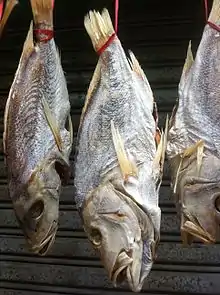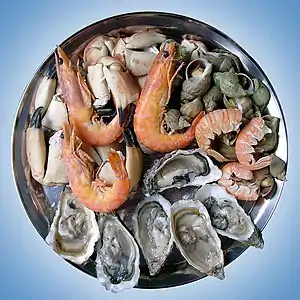Salt-cured meat
Salt-cured meat or salted meat is meat or fish preserved or cured with salt. Salting, either with dry salt or brine, was a common method of preserving meat until the middle of the 20th century, becoming less popular after the advent of refrigeration. It was frequently called "junk"[1] or "salt horse".[2] One early method of salt-curing meat was corning, or applying large, coarse pellets of salt, which were rubbed into the meat to keep it from spoiling and to preserve it.[3] This term originates from Old English and references the large corns or grains of salt used (see wiktionary:corn).[4] Corned beef retains this name, although it is typically brined today.


Salt inhibits the growth of microorganisms by drawing water out of microbial cells through osmosis. Concentrations of salt up to 20% are required to kill most species of unwanted bacteria. Smoking, often used in the process of curing meat, adds chemicals to the surface of meat that reduce the concentration of salt required.
Salted meat and fish are a staple of the diet in North Africa, Southern China, Scandinavia, coastal Russia, and in the Arctic. Salted meat was a staple of the mariner's diet in the Age of Sail. It was stored in barrels, and often had to last for months spent out of sight of land. The basic Royal Navy diet consisted of salted beef, salted pork, ship's biscuit, and oatmeal, supplemented with smaller quantities of peas, cheese and butter.[5] Even in 1938, Eric Newby found the diet on the tall ship Moshulu to consist almost entirely of salted meat. Moshulu's lack of refrigeration left little choice as the ship made voyages which could exceed 100 days passage between ports.
See also
- Bacon – A type of salt-cured pork
- Biltong – A form of dried, cured meat that originated in South Africa
- Cecina (meat)
- Corned beef – Salt-cured beef product
- Cured fish
- Curing – Food preservation and flavoring processes based on drawing moisture out of the food by osmosis
- Dried and salted cod – Preserved fish, one of the main preserved sources of protein for centuries around the Atlantic nations
- Jerky – Lean meat dried to prevent spoilage
- Ham – Pork from a leg cut that has been preserved by wet or dry curing, with or without smoking
- Jamón – Type of dry-cured ham from Spain
- Jellyfish as food
- Jigg's dinner
- Pastrami – Meat preserved by partial drying, seasoning, smoking and steaming
- Salt pork – Salt-cured pork, usually prepared from pork belly, or, more rarely, fatback.
References
- Clarkson, Janet (2009-10-12). "The original junk food". The Old Foodie. Retrieved 2018-05-02.
- Hughes, Robert (1988). The Fatal Shore: The Epic of Australia's Founding. Vintage Books. ISBN 978-0394753669.
- United States Department of Agriculture. "What is corning?". ask.usda.gov. Retrieved 2021-01-10.
- "corn | Origin and meaning of corn by Online Etymology Dictionary". www.etymonline.com. Retrieved 2021-01-10.
- "Diet and Recipes". hmsrichmond.org. 2004-09-02. Retrieved 2018-05-02.

